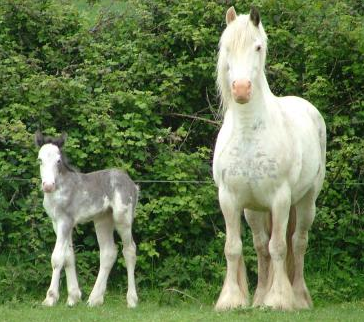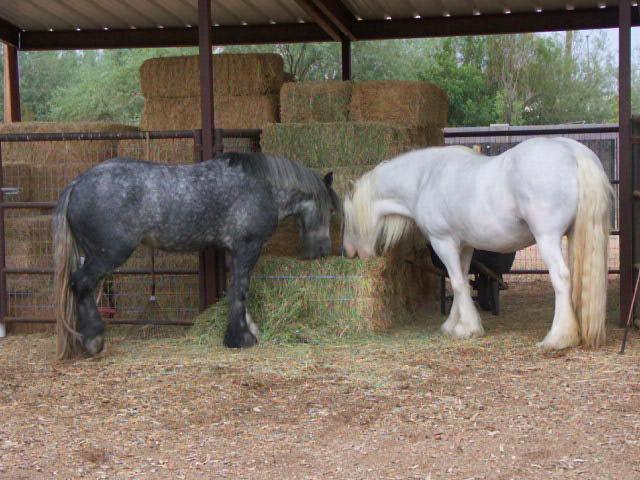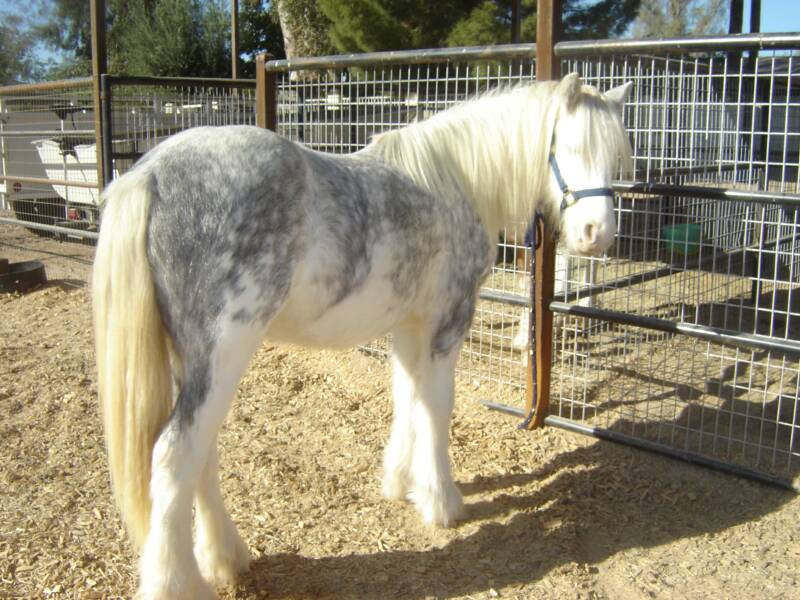Gray Factor in Horses
A lesson in horse color genetics from someone who only understands it a little bit:
This is a picture of Chroicoragh when she was a baby, with her dam in Ireland:
| Clononeen Farm |
Here she is a little older:
Even older:
 |
| Photo by Tami Gramont |
And today:
This is where I have to introduce you to two terms: Homozygous and Heterozygous. Homozygous is dominant. If you have a horse that is homozygous for the black gene, that horse's babies will always be black. If the horse is equally homozygous for the Tobiano gene, that horse's babies will also always be black, and spotted. So for a breeder who loves black spotted horses, having a stallion or mare that is homozygous for black tobiano is a premium. Every foal is guaranteed to be spotted and black. Likewise, if a breeder prefers Chestnuts or Palominos, they will want a horse that is homozygous for Red. There are endless possibilities when it comes to color combination, and unless you have a homozygous horse, you have no idea what the resulting foal will look like. I kind of like it that way. I like surprises.When I first saw Chroicoragh, and a picture of her mom and dad, I had no idea her color would change. As I found out more about blues and grays, I hoped she would keep her beautiful blue blanket. In western terms, her coloring would be called "Blue Sabino," in Gypsy terms, it's called Blue Blagdon. Everyone has a favorite color and pattern. Some love the splotchy pinto patterning that most Gypsy Horses carry, called Tobiano. It can come in any color, but the most common is black. Tobiano is a coat pattern that is carried genetically, as well as coloring.
 |
| Lenny is a Heterozygous Black Tobiano |
Chroicoragh carries one red gene, and one black gene, and is negative for tobiano. Which means she could have a baby that is either red (Chestnut; Sorrel) or black, and would most likely not have a baby with spots unless she was bred to a stallion who was homozygous for the tobiano gene.Following so far? OK, 'cause now I'm going to throw another one at you: Chroi is also negative for the Agouti gene, which is responsible for the black points you see on Buckskins and Bays. (A great example of the Agouti gene in bays is sweet Siofra, a bay blagdon who had a gorgeous buckskin colt, Arthur.)Chroi's color genes look like this:aa (Agouti - negative);Ee (one black, one red); andto/to (Tobiano - negative) So why is she losing her lovely blanket? The only answer, the wild card: The Gray Gene. The gray gene is responsible for most of the white horses you see. Huh? Yes, what you think is a "white" horse is technically gray. Until a few years ago, you couldn't even test for the gray gene. If you had a white or gray horse, you pretty much had a 50/50 chance of getting a gray foal, but you didn't know if it would be a 100% chance. The kicker is, a gray horse can be born any color. Well, besides purple.I had a little foggy inkling that Chroi might not be a true "Blue" horse - blue horses are technically black, with a lot of white hairs mixed in that gives them the bluish or grayish coloring, but don't necessarily carry the gray gene. These horses will remain blue their entire lives, and not fade.
So why is she losing her lovely blanket? The only answer, the wild card: The Gray Gene. The gray gene is responsible for most of the white horses you see. Huh? Yes, what you think is a "white" horse is technically gray. Until a few years ago, you couldn't even test for the gray gene. If you had a white or gray horse, you pretty much had a 50/50 chance of getting a gray foal, but you didn't know if it would be a 100% chance. The kicker is, a gray horse can be born any color. Well, besides purple.I had a little foggy inkling that Chroi might not be a true "Blue" horse - blue horses are technically black, with a lot of white hairs mixed in that gives them the bluish or grayish coloring, but don't necessarily carry the gray gene. These horses will remain blue their entire lives, and not fade.
 And when Keira was born jet black, I was so elated! Then she started showing some gray hairs in her coat, and my suspicions were confirmed. For Keira to be going gray, that means Chroi has to be gray. The question is, Homozygous, or Heterozygous? And why does it matter? Well, like I said, everyone has color preferences. Personally, grays have always been my favorite. I went to YMCA camp when I was 13, and my horse for the week was a tall dapple gray named Dapper Dan *sigh* I loved him. And if you've read my essay, you'll know my white/gray partiality has been with me a long time.But some people don't like grays. A gray horse, over time, will fade to white. And white horses have a higher chance of developing melanoma, or skin cancer. Besides, some people just don't like white. (crazy, I know! How could you not like a white horse?)
And when Keira was born jet black, I was so elated! Then she started showing some gray hairs in her coat, and my suspicions were confirmed. For Keira to be going gray, that means Chroi has to be gray. The question is, Homozygous, or Heterozygous? And why does it matter? Well, like I said, everyone has color preferences. Personally, grays have always been my favorite. I went to YMCA camp when I was 13, and my horse for the week was a tall dapple gray named Dapper Dan *sigh* I loved him. And if you've read my essay, you'll know my white/gray partiality has been with me a long time.But some people don't like grays. A gray horse, over time, will fade to white. And white horses have a higher chance of developing melanoma, or skin cancer. Besides, some people just don't like white. (crazy, I know! How could you not like a white horse?)
So I pulled a few hairs from both girls and sent them off to be tested for gray. The results (drumroll please): Both Chroicoragh and Keira are Heterozygous for the gray gene. That means that while it appears that both of them are gray, and will eventually fade to white, they only have a 50% chance of passing it on to their foals. So that's good news.Why? Well, for Chroi, since she is in foal to Lenny, and he carries the same color traits, their next baby (Keira is the first) has a possibility of being Red or Black, with a lower possibility of being spotted. Lenny is Heterozygous for Tobiano, so it's only a 25% chance. But Chroi has a red half-sister (Desert Jewel Rococco), a non-fading blue half-sister (Desert Jewel Lile), both out of Lloyds, above, and Lenny has thrown quite a few red foals. So it's anyone's guess. There's also a 50% chance that no matter what color the foal is, that it will go gray, like Keira.
 |
| Never mind the brown - that's mud :) |
The great thing about Keira going gray is that she is going to do it beautifully. Her mane and tail are already well on their way to white, and since her whole body is dark, it will dapple out in a gorgeous splash. She won't go fully white until she is well into her teens, and along the way she will look like a living, breathing Carousel horse.Keira is listed for sale. Please visit her page for details: KeiraHere is a new picture of Keira, showing her pretty dapples:
 Here are some examples of Gray factor.Another helpful page on equine genetics, brought to my attention by a reader. (Thanks, Sarah!)
Here are some examples of Gray factor.Another helpful page on equine genetics, brought to my attention by a reader. (Thanks, Sarah!)
| Platinum, Vines Gypsy Horse © Michael Vine |
|







